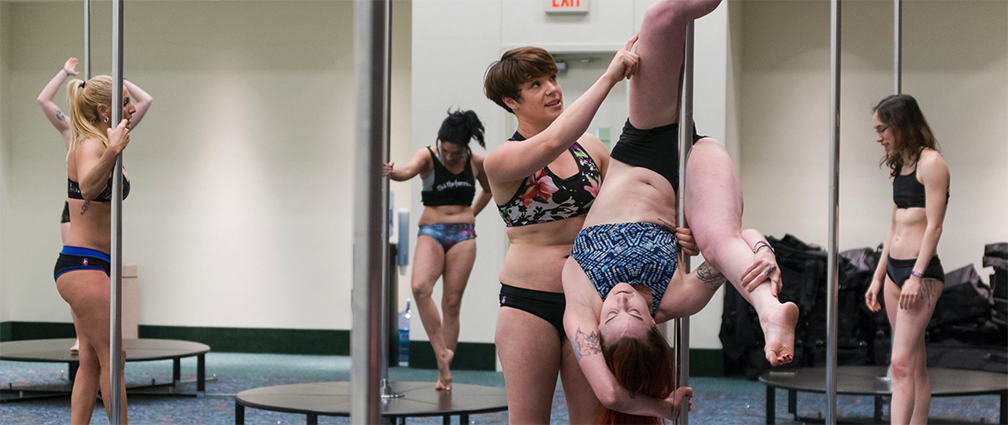FOR IMMEDIATE RELEASE More than 1,500 pole dancers, including people of all genders, all ages,…

Why is posture important?
❓Why is posture important?
Or perhaps more accurately; “how we can use looking at static posture to help us understand how our body is moving or not moving from a wholistic perspective.”
Think of static posture as the body’s alignment in relation to itself and to the earth with respect to gravity. Fundamentally, if you’re in the *right* alignment, you won’t fall down—or the ground won’t rush up to meet you!
To function in the best possible way, with the greatest range of motion and the lowest propensity for pain, the body benefits from being aligned in specific ways at the skeletal level both while static (or standing) and while in motion (or dynamic posture).
Once the skeleton is aligned (think of this as “most efficiently stacked for our body shape”), our muscles, ligaments, fascia, and other tissues can support the skeleton and keep it in alignment and moving well. Conversely, if the muscles, ligaments, fascia, and other tissues are not aligned, they can pull the skeleton out of alignment.
The process of finding balance between the intrinsic (inside the body) and extrinsic (outside the body, like gravity) forces is a constant and literal balancing act that we perform every day, all the time.
What is “bad” posture?
It’s important to note that there is no “bad” posture. I know plenty of AMAZING dancers who have postural challenges like scoliosis, a lateral curvature of the spine, who move well without pain. Just because you have a postural difference from “factory standard” does not mean you cannot be a mover.
Static or dynamic posture that is out of alignment for “too long” (which will depend greatly on the person and situation) can decrease our ability to move easily and/or in a pain-free way. We may find that certain movements are hard to coordinate or just don’t happen.
This could be because of an acute or sudden injury (like a car accident), from repetitive motion or inactivity (like sitting hunched in an office chair for decades), from a body/life change like carrying a child, or even from how we were born (perhaps with one leg slightly longer than the other).
Have you ever driven a manual transmission car? When you smoothly coordinate pressing in on the clutch, releasing pressure on the accelerator, and shifting gears all at the same time, the car continues moving forward without lurching, jerking, or grinding. The body is coordinating TONS of things at the same time, and when all those things work smoothly, we move smoothly. When something is out of alignment, when the pressure is too great on one side and not balanced on the other, or when we lose our ability to connect with our internal “gear shifter” to tell the body what to do, we lurch, grind, halt, and generally have a more difficult time moving.
While this sensation that the body “won’t go” could include multiple factors, we need to be good detectives and first check to make sure the body is aligned as optimally as possible. That alignment should exist before starting any movement and we should maintain that alignment throughout the end of the movement.
Think about your car again (this time it can be an automatic transmission!). When all four tires on the car are balanced and aligned, they all move and wear the same way. If one tire is out of alignment, it can wear faster than the other three tires. That wear can then throw off the balance of the entire car!
Over time, this can cause more expensive and complicated repairs beyond the original issue. If the tires were instead checked regularly and rebalanced to their optimal alignment, these repairs could be avoided or at least mitigated earlier, making repairs cheaper and easier.
Checking in with your posture and maintaining it regularly is one way to assess your body’s alignment and identify areas you can focus on to improve your mobility and potentially decrease pain so that you can move better.
Understanding how we are aligned—or not aligned—is the first step in our detective work of identifying how our body is currently moving. Once we have that information, we can make a plan to move the body closer to a more efficient alignment, which can increase range of movement and may decrease pain.
Ready to play detective?
Remember, this is your baseline. You can modify your baseline to achieve greater alignment starting today! Even though humans have the potential to be symmetrical, very few of us are. A lifetime of movements, like sleeping on one side, favoring one hand over the other, and countless other small daily activities, create compensations that may deviate our bodies from symmetry. If you had an injury, you may have even greater compensations away from symmetry because your amazing brain kept your body as upright as possible, minimizing pain as much as possible.
Grab your phone and set it across the room from you about hip height off the floor. Video yourself standing facing the phone and then with your back to your phone in your normal posture. Remember, our normal static posture often gets a bit better when someone is watching us (even when that someone is a phone), so try to be as natural as possible.
Then turn 90 degrees to capture your side view. Finally, turn 180 degrees to capture your other side view.
Screenshot your video to capture four photos: front, back, left side, and right side.
Now, using a measurement app, draw a line straight down the center of your body from top to bottom on all photos to represent the line of gravity. Draw another line across your belly button cutting your body roughly in half.
Tip: wearing tight fitting clothes will help you see better.
Note where you see differences from one side to the other, like one hip or shoulder higher than the other or one foot pointed out in a different direction than the other.
Don’t assign any “good” or “bad” values to these photos and measurements!
This is the first step to understanding how influencing your posture can improve how you feel and move!
Learn more in the book “Mobility for Pole” available at this link.
Latest posts by Colleen (see all)
- Why is posture important? - June 14, 2024
- PoleCon 2024: Recap - June 5, 2024
- Interview with New PoleCon Instructor: Venus the Virgo - May 24, 2024


